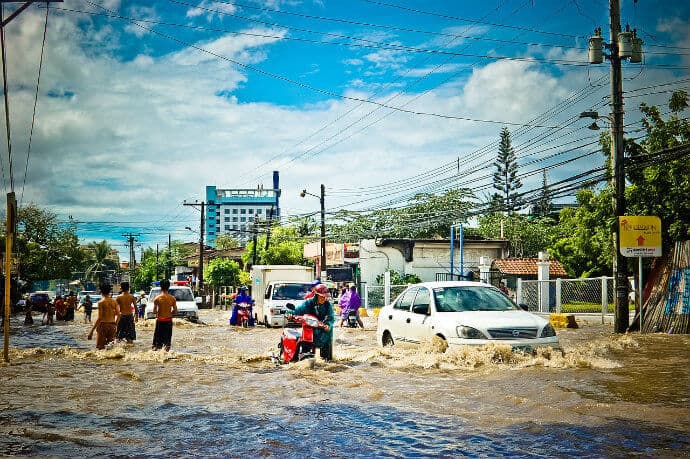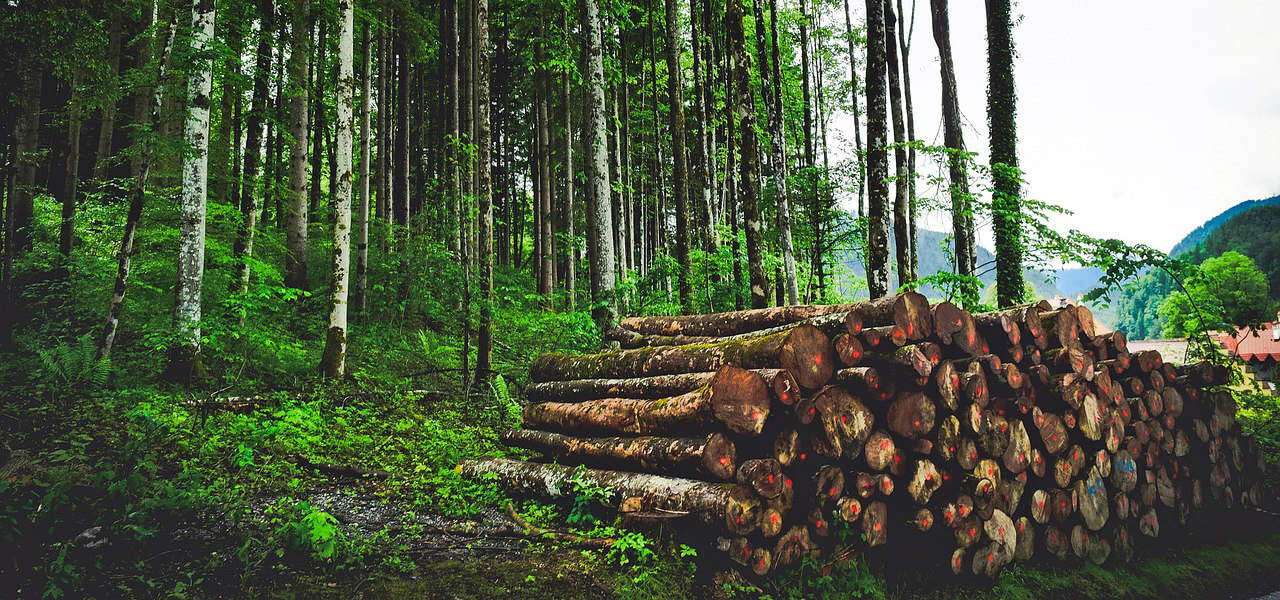Deforestation is amongst the most detrimental activities we, as humans, are doing to cause, accelerate, and exacerbate climate change.
First off, cutting down forests (or, worse yet, intentionally burning them) releases insane amounts of carbon into the atmosphere. It also simultaneously eliminates one of the best natural air cleaning systems the planet has supplied us with, which are those very same forests.
Forests play a vital role in so many things. They’re homes for an incredible array of animals. They are mitigators of floods, and stewards of the fresh water cycle. They help to build soils and balance the global ecosystem. They stabilize coastlines and diffuse heavy winds.
Perhaps most importantly, forests sequester carbon, and they provide us with fresh oxygen for us to breathe. It’s worth noting that forests do not exist on any other known planet in the Universe.
Given these facts about deforestation and its devastating effects on the planet, why on Earth would we allow our forests to be destroyed?
So let’s take a look at the causes of deforestation, its effect on the the environment, some prominent examples around the world, and possible deforestation solutions.
READ MORE: The 20 Biggest Forests in the World
Facts About Deforestation: Contents
- What Is Deforestation?
- The Causes of Deforestation
- Environmental Effects of Deforestation
- Deforestation Solutions
- Deforestation FAQS

What is Deforestation?
When we talk about deforestation, we’re not talking about somebody going into the forest with an axe or chainsaw and chopping down a single tree (or even several trees) for firewood.
Deforestation is the clear-cutting of an entire forest or stand of trees, allowing the land to be converted into farms, ranches, suburbs, etc. This typically involves the use of fire (such as those raging in the Amazon of Brazil) or heavy machinery for mutilation of the entire landscape.
Here are a few basic deforestation facts that will give you some idea of just how much destruction our planet’s forests have endured to date:
1. Forests still cover about 30% of Earth’s land, but humans have been cutting them down at an increasingly alarming rate. In the last 30 years, over 500,000 square miles of forests have been lost.
2. To put that rate of deforestation into perspective, Nature says that research indicates people currently cut down about 15 billion trees a year, or roughly 41 million trees a day!
3. Since the beginning of human civilization, the planet’s forests have decreased by nearly 50%. In other words, wherever people go, trees have disappeared. But the rates of forest destruction have grown exponentially in the age of industrialization.
4. Skeptics claim global warming is just a normal planetary cycle, but science insists that deforestation and climate change are connected. There are obviously other causes of climate change, but the decimation of forests has contributed to the planet’s ecological instability.
READ MORE: 10 Eco Lessons We Can Learn From The Lorax

The Causes of Deforestation
Deforestation happens for many reasons, but the major causes of deforestation are all linked to industrialization.
Unfortunately, we aren’t even making the most of the forests we choose to eliminate. We’re simply removing them to get other commodities, often leaving the trees in a mess of smoldering piles rather than making the most of them.
5. National Geographic reports that agriculture, mining, and drilling combine to account for over half of the world’s deforestation.
6. In the Amazon, the world’s largest rainforest is being felled to grow soybeans and graze cattle to support the industrialized world’s unhealthy obsession with beef. We’re losing the greatest source of biodiversity on the planet in order to grow food that will be shipped thousands of miles away.
7. In Indonesia and Malaysia, where the world’s oldest rainforest is, trees are being cut down at unbelievable rates to make way for palm plantations. Palm oil has become nearly ubiquitous in modern consumer products, from potato chips and toiletries to biofuel.
8. Large-scale mining operations—for gold, copper, diamonds, and more—have also devastated forests, cutting them away to dig massive open pits all around the world. (We’ll save the discussion about the horrible pollution involved in mining for another day…)
9. Obviously, logging has had a considerable effect on forests as well. Wood and paper products account for the majority of the remaining deforestation—some 4 billion trees—that occurs each year.
10. Wildfires are increasingly concerning of late, with California having its largest ever in 2018 and the Amazon ablaze as I write this. But the “wild” in wildfires shouldn’t be confused with occurring naturally: According to Smithsonian, nearly 85% of all wildfires are started by humans.
One major problem is that climate change has dried many of our forests into combustible tinder, and humans play with fire a lot: cigarettes, camping, shooting gun, cooking, heating, etc.
READ MORE: How to Avoid Products With Palm Oil

The Environmental Effects of Deforestation
We’ve already mentioned some of the worst environmental effects of deforestation, including disrupted water cycles, the release of carbon gases, and destroyed wildlife habitat.
But unfortunately, that’s just scratching the surface. Deforestation is ecologically devastating. Deforestation and climate change are inextricably linked. Here’s how:
11. The carbon cycle is hugely disrupted by deforestation. Not only do trees take in carbon and release oxygen, but they also sequester that carbon, particularly in decomposing wood. Slashing and burning the forest releases all of that carbon at once, making it too much for the remaining forest to process. This isn’t how nature was designed!
12. In addition to sequestering carbon, forests sequester other greenhouse gases. Unfortunately, deforestation releases these gases. According to the World Wildlife Fund, deforestation accounts for approximately 15% of all greenhouse emissions.
13. The water cycle is also upset when forests are cut down. The natural system has rain falling onto maritime forest canopies, which catch and return the water to the atmosphere. After that, the water can move further inland. Without this system, continental areas become more desert-like.
14. An opposite problem caused by deforestation is flooding. Forests help to absorb heavy rains, which is how we avoid rivers and lakes overflowing. Without forests to temper the rains, the influx of water becomes too much for the established natural systems to handle. Rivers overflow.
15. Another deforestation-related issue is access to freshwater. Where the forest floor once absorbed water and released it into streams and rivers, now rain flows straight to rivers and then down to the ocean, where it becomes salinized. This rain used to recharge aquifers, but now it drains away.
16. Clear-cutting forests also degrades the soil. Forests store nutrients and feed the soil as part of the natural life cycle of plants and animals. Without these life cycles, the soil isn’t revitalized. After a few years, all the soil fertility is gone, and things start to get more dusty and barren.
17. Without the forest canopy to buffer rains and tree roots to cling to the soil, the earth’s surface is far more susceptible to erosion. According to WW, scientists estimate a third of all arable land has been lost to erosion since the 1960s.
18. The effects of deforestation on animals and plants is similar to that of soil: We’re losing large percentages of countless species. The World Counts suggests that up to 28,000 species of wildlife could be lost in the next 25 years, because 70% of the Earth’s plant and animal species live in forests.
READ MORE: How to Reduce Your Carbon Footprint

Examples of Deforestation
Despite the many negative effects of deforestation, the world economy is built on money rather than sustainability. In short, the fiscal advantages of deforestation have proven too tempting for industry.
Rather than nurturing the land and doing things responsibly and sustainably, more often than not it’s simply cheaper to just cut down more forest.
Here are some of the more prominent examples of deforestation around the world:
Amazon Deforestation
19. As you may have read in the news, deforestation in the Amazon rainforest is rapidly on the rise.
According to The Guardian, the slash-n-burn rates have risen dramatically since the election of Brazil president Jair Bolsonaro in January 2019.
Brazil’s environmental ministry has been greatly weakened, leaving the forests ripely positioned for exploitation.
Ignoring the disheartening facts about deforestation, Bolsonaro stubbornly insists that the agricultural industry will be key to his country’s economic future.
Indonesia Deforestation
20. On the other side of the globe, deforestation in Indonesia is also rampant.
Indonesia has the largest expanse of rainforest in Asia, but the Rainforest Action Network cites studies estimating over 2.4 million acres of forest were felled in the last year alone.
This has made Indonesia the world’s third largest emitter of greenhouse gases after the US (#1) and China (#2).
Unfortunately, these forests are home to endangered animals like Java tigers and orangutans.
Deforestation in Malaysia
21. Deforestation in Malaysia, which has ample rainforests and peat swamps, is cause for concern as well. It, too, is threatening a number of endangered species, including orangutans.
Malaysia’s forests are mostly falling in favor of palm oil plantations, which are heavily reliant on agro-chemicals.
Furthering the problem, wildfires often result from the slash-and-burn method of clearing forests that often takes place there.
Deforestation in the Philippines
22. The rise of deforestation in the Philippines is also largely the result of the palm oil industry.
The increasing popularity of palm oil is one of the major causes of deforestation because, like corn and soy, it has oozed its way into so many of our modern consumer products.
Even Palawan, which is a protected biosphere reserve in the Philippines known for some of the world’s best beaches, is falling victim to the palm oil industry.
Here again, we see the destructive slash-and-burn method of clearing land for agriculture becoming more commonplace. Sadly, it’s simply the way things are done in the palm oil industry.
Deforestation in India
23. Large scale deforestation in India actually dates back to the 1800s, when the British Forest Policy first began to exploit the subcontinent’s natural resources.
That being said, Al Jazeera reports that clear-cutting rates have escalated with the economic development and industrial pursuits of independent India.
Though India has set a goal to keep around 1/3 of its area in protected forests (80% of which was covered 5,000 years ago), it’s currently struggling to stay above 20%. And as the forests continue to disappear, arid deserts are replacing them.
Deforestation in Australia
24. Australia also has a problem with dire desertification due to deforestation.
Deforestation in Australia, which has largely occurred in the 200 years since it was colonized, has wiped out almost half of the country’s forest cover.
This has caused mass extinction and/or endangerment of its unique wildlife, as well as the salinization of its landscape.
Deforestation in the United States
25. While tropical deforestation appears to be the dish of the day, in no way does that indicate a historic trend.
Live Science alludes to a University of Michigan study that found the indigenous forests of the continental United States have been decreased by some 90% since the 1600s.
Unfortunately, it seems as if the country’s current onslaught of regulatory rollbacks are paving the way for more destruction and exploitation of the remaining forests in the future.
READ MORE: How Palm Oil Deforestation Contributes to Climate Change

Deforestation Solutions
Reading about the consequences of deforestation can really get a person down. There are so many disadvantages to deforestation that the benefits seem horribly disproportionate.
The causes and effects of deforestation don’t make sense unless the only thing we care about is money. Thankfully, lots of people are looking for ways to stop deforestation and speak for the trees.
26. Green businesses are one solution that’s helping to lessen our reliance on deforestation for paper products. Instead, we can recycle the materials we already have to avoid cutting more trees for things like toilet paper, boxes, office supplies, etc. Reusing what we can makes a big difference.
27. Eco-forestry is a more sustainable way of utilizing our forests, particularly for timber and wood pulp. Instead of clear-cutting, trees are selectively cut and removed with an effort to minimize damage to the forest and act as environmental stewards of the forest rather than exploiters.
28. Numerous NGOs are focused on the conservation of forests, particularly those in the Amazon and Indonesia, which account for a huge percentage of the planet’s biodiversity. Check out The Nature Conservancy, Rainforest Trust, World Wildlife Fund, International Union for Conservation of Nature, and The Natural Resources Defense Council to get a feel for the efforts already underway.
29. Responsible land use planning is another way to stop deforestation. Rather than constantly allowing cities and towns to sprawl and cutting down more forests to make room, we need to realize the potential of the spaces we already have.
We can reinvigorate downtown areas rather than building more suburbs. We can practice more sustainable farming methods to keep the land fertile and productive. We can link our food production to population centers, and return to consuming more locally produced foods.
This would ensure that we aren’t cutting down the Amazon rainforest for hamburgers in New Jersey. Plus, we’d eliminate so many food miles in the process!
30. Lastly, there’s inspiration from reforestation. Though reforestation doesn’t necessarily prevent deforestation, it does create new forests, and it’s developing into a huge movement:
- Conservation International has recently kickstarted a six-year effort to re-tree some 70,000 acres in the Amazon.
- A man in India planted a 1300-plus acre forest by himself, in addition to the work of the aforementioned NGOs. It proves just how much difference one passionate person can make.
- Look into WeForest and Eden Reforestation Projects for details on growing new forests.
READ MORE: Going Green: 60 Earth Day Tips You Can Use Every Day
Deforestation FAQS

Where does deforestation occur?
Deforestation occurs all over the world. But human population centers are where most deforestation has historically happened.
For instance, the US has only about 10% of the indigenous forests it had when Europeans arrived. India suffered a similar fate, as did Australia.
That said, the rate of deforestation has increased dramatically in the last couple of centuries because mechanization has made it easier and we now transport our needs from afar.
The most significant deforestation currently underway involves tropical forests, namely in the Amazon, Indonesia, and Malaysia.
Other countries with high deforestation rates that don’t often make the headlines for it include Paraguay, Guatemala, and Cambodia. Even eco-conscious Finland and Sweden make the list!
What are the primary causes of deforestation?
The simple answer is humans, and the main reason for deforestation by humans is profit and greed.
Forests are cut down to grow monocrops of oil palms, to graze cattle or grow food for livestock, to mine for precious gems and metals, and to create new industrial development.
It’s true that lumber and wood pulp (for paper) do account for significant forest loss. But these older offenders, under the decades-long glare of environmentalists, have painstakingly inched towards more green and sustainable methodologies.
Because clear-cutting forests contributes to climate change, raging wildfires brought on by humans are becoming a major cause of deforestation. They’re also highly destructive to the development that was created from cutting down the forests in the first place, as we’ve seen in California.
What are the effects of deforestation?
Most of us are aware of the deforestation effects on animals: They lose their habitat, primary sources of food, and migratory corridors.
Most of us know that trees trade oxygen (into the atmosphere) for carbon (out of the atmosphere). But we might not be aware that cutting down forests releases mass quantities of stored carbon into the atmosphere.
Deforestation also increases land erosion. Adding to that problem, deforestation disrupts the water cycle, creating severe aridity in some places and flash flooding in others.
It also creates ideal conditions for giant wildfires to both burn the remaining forests and the development that replaced the deforested forests.
READ MORE: 15 Ways to Reduce Waste & Move Towards Waste Free Living

What animals are affected by deforestation?
The impacts of deforestation on animal species are stark.
The places on the planet with the largest amount of biodiversity—tropical rainforests in the Americas, Southeast Asia, and Africa—are currently the blinking red lights on the deforestation map.
Animals impacted by deforestation include Orangutans, Tigers, Asian Elephants, Kangaroos, Darwin’s fox, Amur Leopards, Jaguars, Bonobos, and the list goes on and on…
Deforestation is one of the leading causes of wildlife endangerment, and that’s even before the effects of deforestation-related climate change are calculated into the mix.
How do you prevent deforestation?
How to prevent deforestation is a major question, but it isn’t really that difficult to answer: Stop cutting down forests, and urge your elected officials to protect them, for the planet’s sake.
Most of us aren’t physically doing the work of deforestation. But avoiding the really troublesome products—palm oil, beef, new virgin timber, soy-based animal feed, new housing developments—is something we can all do as individuals.
We can support some of the conservation NGOs listed in this article. We can also buy green paper products, such as toilet paper, copier paper, greeting cards, napkins, and cardboard boxes—when available, as well as participate in recycling paper products to be used for these means. –Jonathon Engels; lead image by David Mark via Pixabay




